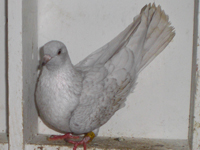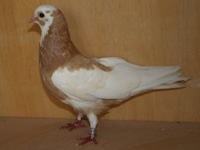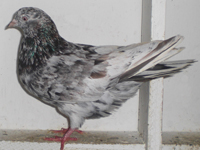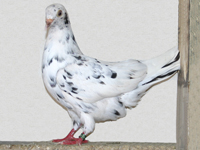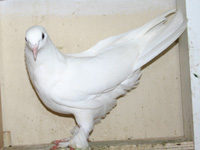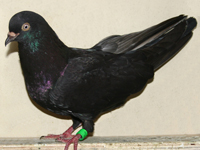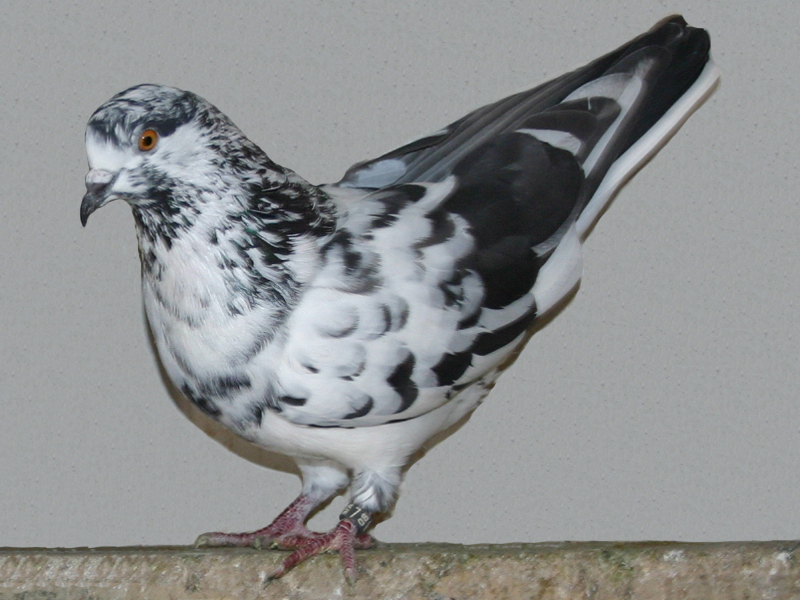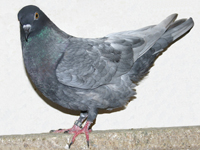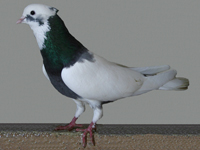
9. X-Pigeons |
||||
~ PIGEON PATTERNS ~


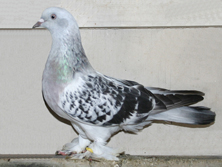
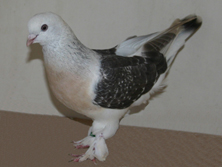
There are four pigeon patterns. Barless (c), Bar (C+), Checker (C), and T-pattern Checker (CT). I have the patterns listed from left to right in order of dominance with barless being at the bottom. Click on each picture to enlarge them.
The examples above are given for the blue series, but patterns can also be seen with other mutants like ash-red, brown, hetero indigo, hetero grizzles, milky, dilute, pale, reduced, extreme dilute (lemon), frill stencil, toy stencil, ice, recessive and dominant opal, all heterozygous and hemizygous almond series, dirty, etc. The pattern is located in the c locus, and therefore represented using the letter c and inherited independently of feather color mutations. Wing pattern phenotype is controlled by an autosomal (not sex-linked) single gene. Thus, each pigeon inherit two copies of the pattern gene, one from each parent.
I have mentioned the word wild-type in almost every page so far, because it is a very important concept to understand when studying the inheritance of traits. The wild-type gene in a multiple allelic series, like the wing pattern, can be dominant or recessive to other alleles. In the pattern series, the bar pattern has been chosen as the wild-type but many people in the past and even today still argue about which pattern should be the wild-type; check or bar. Once the earlier scientists agreed on Columba livia to be the ancestor of modern breeds of pigeons, Darwin believed the barred type to be the original, while checked birds were probably due to “the extension of these black marks (black bars) to other parts of the plumage” (Darwin 1868, vol. 1, p. 183). Another scientist, Whitman suggested that the barred type resulted from a gradual clearing of the wings of checks” (Whitman 1919, vol. 1, p. 19). Rock Pigeons display many variations among their numbers scattered throughout the world but the argument rages on yet, as to whether the earliest forms were barred or checkered. There is no reason at all for a student of pigeon genetics to get into the chicken or the egg causality dilemma, commonly stated as "which came first, the chicken or the egg?" The standard is chosen and what some of us don’t realize is that the standard doesn’t have to be the most dominant in a given population. When studying genetics, we choose a standard because it allows two people to talk about genetics without wasting all of their time defining the standard they are using every time they talk to a new person. So, it doesn’t matter which pattern was chosen as the wild-type. Gmelin (1789), who was the first person to report and describe Columba livia, choose this phenotype, and consequently the barred genotype became the wild-type in pigeons. However, once the phenotype for wild-type is chosen, we can not change it; otherwise, we would have to test everything to this new wild-type phenotype.
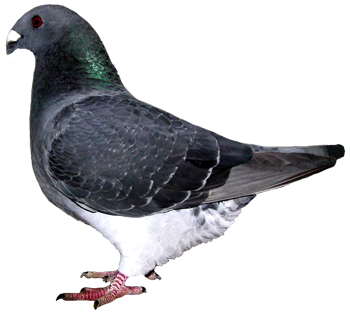 The
most dominant gene of the pattern series is called the T-pattern
checker (gene symbol
CT) where a few light
edges or triangles as "check" in
the wing shield area are visible. T-Pattern check gets
its name from the small light colored T in the check pattern
of
their
wing
shield feathers which can range from the wing shields showing
light colored "T"s on each feather, to having the
whole wing look like black. Thus, the common names of this
pattern among pigeon fanciers are "velvet", or "blue-tailed
black" (See picture on the right). It is also important
to note that the T-pattern check phenotype with the help
of darkening factors like sooty, dirty, and smoky can easily
be confused with a spread phenotype. However, although spread
and pattern are linked genes (located on the same chromosome),
spread is a different mutation located on a different locus
and therefore is not part of the pattern series. Unlike
spread mutation, the T-pattern check birds have regular flight
and tail feathers with the
sub-terminal tail band, and albescent strip. In addition,
T-pattern check birds, just like the rest of the pattern
series, might have colored or white rumps where
the spread mutation would normally cover the rump feathers. Spread
is known to be epistatic to pattern series, therefore when
there is a spread gene present in the genotype, it suppresses
the effects of pattern and make the pattern not visible in
the phenotype.
The
most dominant gene of the pattern series is called the T-pattern
checker (gene symbol
CT) where a few light
edges or triangles as "check" in
the wing shield area are visible. T-Pattern check gets
its name from the small light colored T in the check pattern
of
their
wing
shield feathers which can range from the wing shields showing
light colored "T"s on each feather, to having the
whole wing look like black. Thus, the common names of this
pattern among pigeon fanciers are "velvet", or "blue-tailed
black" (See picture on the right). It is also important
to note that the T-pattern check phenotype with the help
of darkening factors like sooty, dirty, and smoky can easily
be confused with a spread phenotype. However, although spread
and pattern are linked genes (located on the same chromosome),
spread is a different mutation located on a different locus
and therefore is not part of the pattern series. Unlike
spread mutation, the T-pattern check birds have regular flight
and tail feathers with the
sub-terminal tail band, and albescent strip. In addition,
T-pattern check birds, just like the rest of the pattern
series, might have colored or white rumps where
the spread mutation would normally cover the rump feathers. Spread
is known to be epistatic to pattern series, therefore when
there is a spread gene present in the genotype, it suppresses
the effects of pattern and make the pattern not visible in
the phenotype.
In this page, the pattern phenotypes of the blue series are listed in the order of their progressive decreasing amount of black in relation to blue, and it is very interesting that they appear to be epistatic in their hereditary manifestation in the same order, i.e., each to the one that follows. However, when we describe the relationship between the allelic genes, we used the words like dominant, recessive, and co-dominant, and use the word epistatic when we describe the relationship between non-allelic genes.
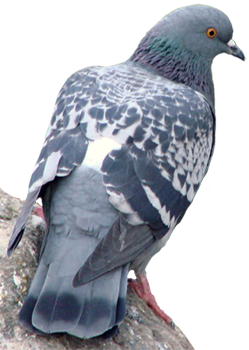 In
the pattern allelic series, recessive
to the T-pattern check is called checker or
check (gene
symbol C),
showing several triangular checks of light gray or "blue" in
the blacker wing shield area (See picture on the left).
The
word check originates from the so-called checkerboard appearance of the
wing. This condition is caused by the presence of two
black marks situated respectively in the inner and outer vanes
of the wing coverts, the central and proximal portions
of which are blue. The rest of the plumage of checked
birds is blue with the invariable exception of a black terminal
band on the tail and of the not infrequent presence of
checks on the upper back. The rump may be either very
light, almost white, or a shade of blue uniform with that of the
wing coverts, or any shade between these two colors.
According to Sarah van
Hoosen Jones (1921), somewhat similar checked patterns are found
in Columba guinea and many of the doves (mourning doves, ground doves,
etc.); in fact a large number of the individuals of the order Columbae
exhibit check pattern. The genetic behavior of the checks of Columba
livia and of the doves are probably caused by the analogous
mutation at
the same spot on the chromosome. Since all Columbae are related evolutionarily,
major parts of their genomes expected to be identical.
In
the pattern allelic series, recessive
to the T-pattern check is called checker or
check (gene
symbol C),
showing several triangular checks of light gray or "blue" in
the blacker wing shield area (See picture on the left).
The
word check originates from the so-called checkerboard appearance of the
wing. This condition is caused by the presence of two
black marks situated respectively in the inner and outer vanes
of the wing coverts, the central and proximal portions
of which are blue. The rest of the plumage of checked
birds is blue with the invariable exception of a black terminal
band on the tail and of the not infrequent presence of
checks on the upper back. The rump may be either very
light, almost white, or a shade of blue uniform with that of the
wing coverts, or any shade between these two colors.
According to Sarah van
Hoosen Jones (1921), somewhat similar checked patterns are found
in Columba guinea and many of the doves (mourning doves, ground doves,
etc.); in fact a large number of the individuals of the order Columbae
exhibit check pattern. The genetic behavior of the checks of Columba
livia and of the doves are probably caused by the analogous
mutation at
the same spot on the chromosome. Since all Columbae are related evolutionarily,
major parts of their genomes expected to be identical.
It seems the wing bars on checker pattern are usually wider than the barred birds when some checkers show the wing-bars while some do not. The T-pattern check, check, and the bar patterns actually intergraded, possibly from modifying factors or more likely from intermediate alleles. According to Hollander, the checker pattern has been subdivided according to the amount of spreading into several sub-types. Thus, Hollander identified two additional checks in the pattern series: dark checker (CD) which comes inbetween T-pattern check and check, and the light checker (CL), which comes inbetween check and bar patterns. I will purposely neglect these additional pattern alleles for the time being, because not much is known or reported about them. It seems for an allelic series like pattern to have many different phenotypes, where we know of at least six alleles might be caused by not genes and very likely with a large dose of epigenetics. Nevertheless, one can almost always distinguish these different check patterns in pigeons.
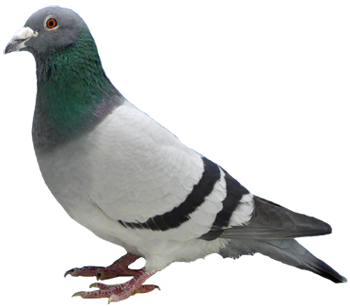 The
wild-type (C+)
gene in this allelic series produces the bar
pattern,
where the barred bird has
two very distinct bars across
the
distal end of the wings. Recall that bar pattern is our
standard and therefore represented with a plus sign (+).
Both T-check and check alleles are dominant to wild-type
(bar pattern). Although this wing pattern is also seen in many other
mutant colors (ash-red, brown, indigo, opal, etc.), in pigeon genetics “Bar” refers
to the pattern commonly called “blue-bar” in
the blue series. The
wing shields of a barred bird are blue with two transverse black
wing bars, one of which extends through the tertiaries and innermost
secondaries,
while the second extends through most of the secondary coverts.
In a bar phenotype, the tail and rump are similar to those of the
check, but the rump is
free from any check marks. According
to Hollander there are smooth and coarse spread areas found in the feathers
of pigeons.
Smooth simply describes the smooth color transition seen on
going from the blue area of the tail feather to the black area of the
tail bar. This transition is a smooth gradation and can easily
be
seen
by the naked eye, which is the tiny area that is neither black
nor blue right on the edge of the tail bar.
The
wild-type (C+)
gene in this allelic series produces the bar
pattern,
where the barred bird has
two very distinct bars across
the
distal end of the wings. Recall that bar pattern is our
standard and therefore represented with a plus sign (+).
Both T-check and check alleles are dominant to wild-type
(bar pattern). Although this wing pattern is also seen in many other
mutant colors (ash-red, brown, indigo, opal, etc.), in pigeon genetics “Bar” refers
to the pattern commonly called “blue-bar” in
the blue series. The
wing shields of a barred bird are blue with two transverse black
wing bars, one of which extends through the tertiaries and innermost
secondaries,
while the second extends through most of the secondary coverts.
In a bar phenotype, the tail and rump are similar to those of the
check, but the rump is
free from any check marks. According
to Hollander there are smooth and coarse spread areas found in the feathers
of pigeons.
Smooth simply describes the smooth color transition seen on
going from the blue area of the tail feather to the black area of the
tail bar. This transition is a smooth gradation and can easily
be
seen
by the naked eye, which is the tiny area that is neither black
nor blue right on the edge of the tail bar.
The word “spread” used here should not be confused with the spread mutation (S) but the sub-terminal tail bar is described as smooth spread by Holllander. The coarse spread on the other hand is once again the name chosen by Hollander to describe the appearance of the tiny transition region between blue part of the feather and black part of the pattern. This transition does not happen smoothly as it does with the tail bar. Rather, the pigment in the transition area is distributed such that there are dark specks surrounded by lighter areas. Thus, this transition region has a grainy naked eye look to it which Hollander properly described as coarse.
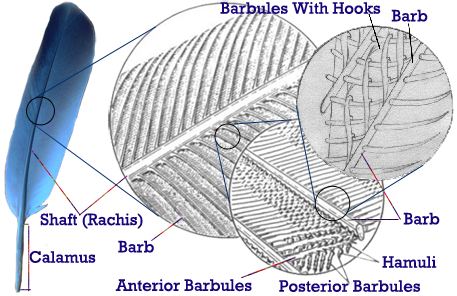 Cole
and Hollander were convinced that the pigment which provides the
coloring matter in our birds’ plumage, came in two different
arrangements. In the bars, pigment was spread out. In the rest of
the feather it was clumped. They thought when the black pigment is
clumped together in the cells of the feathers, it refracts the light
in such a way that we see a bluish tinge as in wing shield of the
blue bars. Cole
in 1914 claimed that the granules in the barbules of a black feather
to be evenly distributed and those in a blue feather to be clumped.
These two conditions have been found, as might be expected if checks
are a combination of black and blue, existing side by side in the
feathers of checked birds. It is this difference in pigment arrangement
that produces the two different optical effects.
Cole
and Hollander were convinced that the pigment which provides the
coloring matter in our birds’ plumage, came in two different
arrangements. In the bars, pigment was spread out. In the rest of
the feather it was clumped. They thought when the black pigment is
clumped together in the cells of the feathers, it refracts the light
in such a way that we see a bluish tinge as in wing shield of the
blue bars. Cole
in 1914 claimed that the granules in the barbules of a black feather
to be evenly distributed and those in a blue feather to be clumped.
These two conditions have been found, as might be expected if checks
are a combination of black and blue, existing side by side in the
feathers of checked birds. It is this difference in pigment arrangement
that produces the two different optical effects.
We now know there are no such things as clumped pigments. But first let’s talk about the parts of a feather, in order to better understand the coarse and the smooth areas of the feathers.. The main shaft of a feather is called the rachis. This is the quill that sticks out of the skin. The fine rod shaped structures that come out of the rachis at more or less a 45 degree angle are called barbs or barb shafts. There is stuff coming out of the barb on both sides at about 45 degrees. These tapered rod shaped structures are called barbules. Out on the sides of the barbules are the hook like things that hold the feather structure together called barbicles.
According to Dr. Richard
Cryberg, there is a distinct size difference for the pigment granules
in smooth
spread areas and coarse spread areas. Smooth spread has granules
too small to resolve in an optical microscope while coarse spread
granules are easy to resolve. Ordinarily in pigeons the bar area
of the tail and the ends of the primary flights are smooth spread
and the rest of the birds pigment is all larger granules. The
large granule area includes both the bar and non bar areas of the
wing
as well as the non bar area on the tail. Genes like dirty and
smoky do not change this relationship. Two genes that have a major
impact
on the whole bird are dilute and spread. Both of these genes
make the granules very small compared to the normal size granules
for
that area. In the case of spread the granules are likely as small
all over the bird as they are normally only in the tail bar and
primary ends. Dilute gives less extreme reduction in sizes such
that the
granules can still be resolved with an optical microscope. According
to Cryberg, when we look at a single barb with its attached barbules
what we would see is nearly all the pigment is in the barb shaft
itself. This pigment in the barb shaft is uniformly distributed.
Only a tiny bit gets out into the barbules. This tiny bit in
the barbules is what Cole called clumped pigment. However, in reality
they are not clumped at all. Each pigment granule is separated
from other granules by several wavelengths of light distance. So,
the
pigment is not clumped; it is simply deposited in islands surrounded
by non pigmented areas. 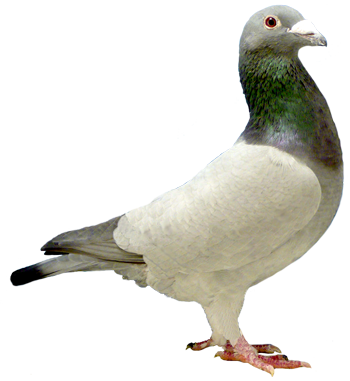
Finally, the least dominant allele in the pattern series, even recessive to the wild-type (bar pattern) is the barless pattern (gene symbol lower case c indicating it's recessiveness to wild-type). Barless in the blue series looks like the wild-type phenotype, but it lacks the bars where the wing shield is clear and has no markings. Barless mutation, which used to be a fairly rare mutation in most domestic pigeon breeds, is now very common in many breeds. As the name implies, the wings lack any bars, which makes the distinction between this type and bar very easy. In a barless individual, the so-called blue colored feathers have entirely replaced the black wing bars leaving a clear blue wing, except for the darkened tips of the primaries, secondaries and tertiaries. Barless is an autosomal recessive trait that is symbolized as (c//c), which can be the only condition (homozygous state) for pigeons to show barless pattern in their phenotypes. Therefore, a pair of barless can produce nothing but barless offspring.
Although barless gene most of the times acts like a simple recessive trait, both Graefe and Quinn reported that for some reason barless gene does not segregate out like an ordinary recessive gene. It seems we have three curious cases with the barless mutants: First, from the Hollander’s report on pattern, we don’t know why wild-type birds heterozygous barless crosses (+//c X +//c) produce less than expected 1 in 4 ratio, but checks that are heterozygous for barless produce the expected 1 in 4 ratio. Second, in some cases wild-type heterozygous for barless show narrowness of the wing bars but in some cases it doesn’t. Lastly, there seems to be a strange relationship between foggy vision and barless pattern but this curious case only shows up in some barless birds. We probably won’t get real good answers to these questions from the breeding results, and will have to wait until the pigeon DNA is sequenced. Click here to read more about the barless pattern.
When we look at the pattern, it is to be noted that color appears in the rump and in the outer vanes of the outer tail feathers (albescent strip) are inherited independently of the pattern series. It should also be noted that even though each pattern darkens or lightens the feather colors, the effect of pattern series is more distinctive on the wing shields. The patterns differ from each other only in the amount and position of coarse spreading. The barless pattern lacks it almost entirely; the other patterns show in serial array increasing invasion in the wings, the crop, and finally nearly all the body feathers anterior to the tail.
According to Sarah van Hoosen Jones (1921), “sooty” has often been lumped with checker, but it is not allelic to pattern series. The sooty can be misleading if it is present with the checker pattern and can make the bird look like a T-pattern Check, make the T-pattern Check look like Spread, and make the Barred birds appear as a Check. Despite a perfectly graduated series of patterns, sharp segregations occur frequently and in pattern series dominance is parallel to the amount of “spreading” involved in the wing shield. In 1938, W. F. Hollander reported pattern inheritance of Columba livia as part of his PhD thesis at the University of Wisconsin. According to Hollander’s study, pigeons have at least six alleles in the pattern series which are Barless (c), wild-type (C+), Light Checker (CL), Checker (C), Dark Checker (CD), and T-pattern Checker (CT). Bar pattern is our wild-type in this multiple allelic series and barlessness is the only recessive allele to the wild-type.
The gene symbols in order of decreasing dominance are CT >CD> C >CL> C+> c
The highest order of dominance can hide anything below it, but nothing above it. This means that two barred (wild-type) parents cannot produce a T-pattern check, or check offspring. There are 6 different alleles for the pattern and each gender carries 2 alleles for any of the patterns that are shown above. The pattern therefore is not sex-linked because every pigeon, male or female carry two alleles for pattern. This makes both sexes homozygous or heterozygous for any of the multiple allelic pattern series. A hen can be heterozygous bar carrying barless or homozygous T-pattern checker (both alleles for pattern is T-pattern checker). But she cannot be heterozygous bar carrying checker, because dominant pattern will always show in the phenotype, and will not be hidden! Unless, of course other mutations are present like spread, recessive red, recessive white, and albino which are all epistatic to pattern series. During mating, each gender donates one of the alleles for the pattern that they carry and the offspring will then show the dominant pattern it receives from both of its parents. If the offspring receives same allele patterns (both bar, or both checker, etc.) then the pattern would be homozygous, otherwise it will be heterozygous at the c locus.
So,
recapping quickly. The pattern is located in different locus,
known as the c locus (locus is different
forms of a gene at a particular physical location on a chromosome)
and
therefore
inherited independently of feather colors. The
pattern does not occur only on blue series
but in
every other
mutants except
color modifiers like recessive red, spread, and recessive
white because these mutations are epistatic to pattern. Understanding
the pattern and their inheritance is very
important to breeders interested in color, especially to the breeders
of Toy Stencils, Oriental Frills, etc.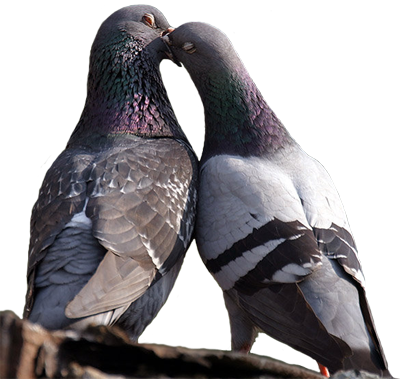
Let’s apply Mendelian genetics from breeding data to illustrate the inheritance of pattern in pigeons. Let’s assume that members of P1 generation are all homozygous in the following breeding example. We know that pigeons exhibit a checkered or bar (wild-type) pattern as part of the pattern series, and the loci responsible for pattern is located in an autosomal chromosome. Therefore, each gender of pigeons carries two alleles for the pattern gene. In a series of controlled mating, the following data were obtained:
. |
F1
PROGENY |
|
P1
Cross |
Checker |
Bar |
(a) checker
X checker |
36 |
0 |
(b) checker X
bar |
38 |
0 |
(c) bar X bar |
0 |
35 |
Then F1 offspring were selectively mated with the following results. (The P1 cross giving rise to each F1 pigeon is indicated in parentheses.)
. |
F2
PROGENY |
|
F1
X F1 Crosses |
Checker |
Bar |
(d) checker
(a) X bar (c) |
34 |
0 |
(e) checker
(b) X bar (c) |
17 |
14 |
(f) checker
(b) X checker (b) |
28 |
9 |
(g) checker
(a) X checker (b) |
39 |
0 |
When we look at the mating (d) where F1 x F1 mating from cross (a-homozygous checker) and (c-homozygous bar) shows the expected 4:0 ratio. When we look at the mating (e) where F1 x F1 mating from cross (b-heterozygous checker carrying bar) and (c-homozygous bar) shows close to 50% where 17 offspring were checkered and 14 were barred. When we look at the mating (f) where F1 x F1 mating from cross bxb (b-heterozygous checker carrying bar) shows 3:1 ratio. From these results and ratios of Mendelian breeding data, we can clearly make the assumptions that checker and bar patterns are alleles and checker is dominant to bar (wild-type) pattern.
How to breed a barless pattern from one barless parent:
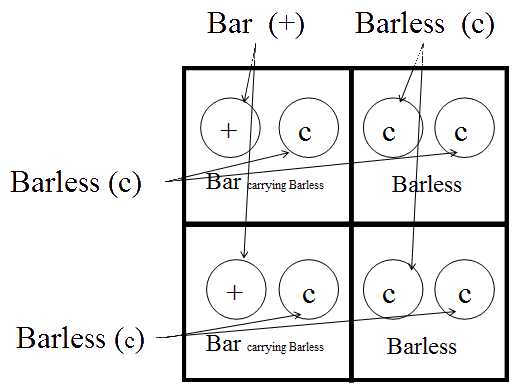 Barless
is a recessive autosomal mutation that pigeons must have in their
genotype in order to produce
more offspring. That means both of the parents must carry it in heterozygous
state or show it in homozygous state. Being at the bottom of the
dominance
of pattern series, it takes couple of generations of inbreeding to
get barless. At the moment I have a pair of barless rollers but I
am not very happy with their rolling performance. So, my goal is
to breed them with better performers and then breed the offspring
back to the barless parent to keep the barless pattern and add performance
to them.
Barless
is a recessive autosomal mutation that pigeons must have in their
genotype in order to produce
more offspring. That means both of the parents must carry it in heterozygous
state or show it in homozygous state. Being at the bottom of the
dominance
of pattern series, it takes couple of generations of inbreeding to
get barless. At the moment I have a pair of barless rollers but I
am not very happy with their rolling performance. So, my goal is
to breed them with better performers and then breed the offspring
back to the barless parent to keep the barless pattern and add performance
to them.
Let's say I have a barless hen. She must be homozygous barless in order to show the barless pattern, as barless is expressed only in homozygous state and her genetic symbol for pattern would be represented as c//c. If I cross her with a homozygous wild-type (bar) cock, both alleles for pattern is bar and represented as +//+. All of the offspring from this mating would be heterozygous bars carrying barless (+//c). Now, if I cross the male F1 from this mating, back to his barless mother I would get: 50% barless and 50% heterozygous bar carrying barless.
The punnet square shown on the right is the demonstration of this mating. By keep inbreeding them, I can keep the barless pattern and add performance to them. Unfortunately, the color and the pattern are easier to put in to a breed than the performance genes, because performance genes in pigeons are also co-dominant traits and they are very hard to put in and maintain.
Barless is a fairly rare mutant in most domestic pigeon breeds and often confused with other modifiers (mutations). I have heard a lot of people calling magpies, spread indigos (andalusions), recessive reds even white-selves (I actually heard that one!) as barless. I have also heard people calling a T-pattern checker as spread. It is actually very easy to separate a spread from a T-pattern by just looking at their tail band. T-pattern Checker, Checker, Bar and Barless birds will have subterminal tail bands and you can actually see a white line on the edges of end tails known as the albescent strip; unless the bird is an ash-red. Ash-red is a mutation where the tail bar is not brick red that we would expect to see. Instead, we find that it has been washed out to an ashy-gray color just like the color that we found on the edges of the wing's flight feathers.
Breeding
bar pattern from two chequer parents: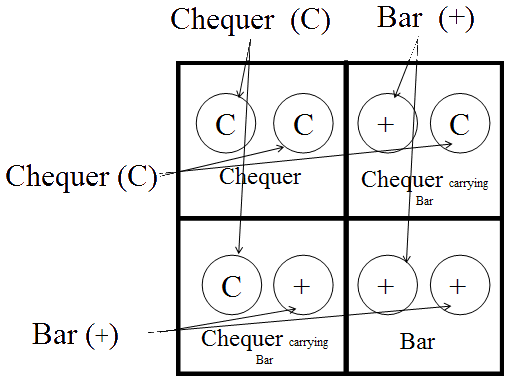
I once received an email from someone wondering how in the world he got a bar pattern from two chequer (alternate spelling of checker) parents. The answer is very simple. In order for two chequers to produce a bar pattern, both parents have to be heterozygous for chequer carrying bar (C//+). Both parents must have been carrying the bar pattern in this case in order to produce a less dominant bar pattern from two chequer parents, and both parents must have donated the bar pattern to the offspring. From this mating there is 25% chance or 1 out of 4 babies will be a bar pattern. We must understand that, this is just a possibility and does not mean every 1 out of 4 every babies will be a bar. It just means there is 25% chance that the baby will be a bar pattern.
When we mate this pair, can we get 4 out of 4 bar pattern babies? The answer is YES, but the chances of getting a bar pattern baby is 1 out of 4 and therefore the possibilities of getting 4 out of 4 babies as bar pattern in a row is in 1 out of 256 chances (1/4 x 1/4 x 1/4 x 1/4).
The punnet square on the right demonstrates how this is possible. 25% of this mating will be Homozygous Chequer (both alleles for patterns are chequers) as it is shown on top left sequare. In addition, 50% of the offspring from this mating will be Heterozygous Chequers carrying Bar just like the parents, as it is shown on top right and bottom left squares. And, 25% will be bar shown on the bottom right square.
Spread:
First thing we need to understand is that, spread is not a pattern and it is located in a different locus than the pattern therefore inherited independently from the pattern. Dr. W. F. Hollander thought spread pattern S and checker pattern C are not independent, but loosely linked. He suggested breeders to introduce T-checker to their spread birds to make them deeper color and reinforce the spreading. In Hollander's PhD thesis he presented data that clearly shows spread and pattern are not alleles but they are linked genes with crossover % of 44% in cocks and 15% in hens. Looking at this data, it needs to be pointed out that Hollander’s %s are at least +/- 5% for both cocks and hens for a 95% confidence limit. Still, there is no overlap in ranges so the difference in crossover rates is without a doubt quite real. As sex differences in crossover rates happen all the time there is no reason at all to find this difference unusual. In addition, we have to remember that, there can be quite a variance within each sex when you compare one individual to another. This is pretty easy to document today using studies where individual sperm are sequenced. So, for individual cocks some might well have this crossover as low as 35% and others 50%. Remember that crossover rate can be affected by sex, age, temperature, proximity of allele to the centromere, inversion and many other factors. It also can vary from individual to individual a great deal.
According to Hollander, it is strange that in spite of centuries of breeding black pigeons all over the world, no mimics or mutant alleles of S have been demonstrated. Spread seems to stand alone in its glory. It looks very similar to T-pattern checker. However, T-pattern birds have regular flights and tail with the sub-terminal band. By looking at the sub-terminal tail band, we can determine if the bird is Spread or T-pattern Checker, as spread birds don't have the sub-terminal tail band or the albescent strip. The spread gene, whether in the heterozygous or homozygous state, has the same effects on the overall body coloration. When a bird is spread, it is no longer possible to see the pattern of bird. This is called epistasis, where the spread factor makes it impossible for us to see the expression of the pattern series alleles. Spread makes an otherwise blue pigeon a spread black pigeon, where spread is said to be epistatic to the genes for pattern. Spread is dominant mutation and even a single copy of the spread gene will make that bird spread. In addition, spread in homozygous state (two copies of spread gene) will make that bird a lot darker than the heterozygous state.
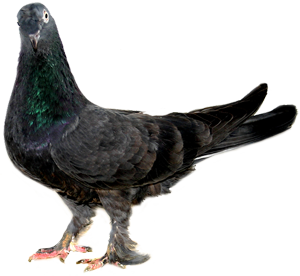 I think it is important
to mention that sometimes spread doesn’t exactly hide
the pattern, the albescent strip or the sub-terminal
tail band. All the genetic terms trace
back to when only few examples were known and even those examples
may not have been all that well understood. Therefore, sometimes
the original rigid definition of the gene or the explanation of
the phenotype leaves false impression that most genetic things
are well defined. As we discover new things, we realize that there
are exceptions to many well defined phenotypes and how some genes
might give different phenotypic results depending on absence or
presence of other mutations. This could create confusion and frustration
to students of genetics in the beginning when they start thinking
of everything in terms of black and white. Worse, what seems
as
black and white
in one case can be grey in another case. In reality, with experience,
we find that there are all kinds of grey, and hardly any black
and white, areas in genetics. Even though spread gene may not
be 100%
epistatic to pattern genes it is fine
to say
that spread is very nearly
epistatic to pattern. There are a lot of things that we don’t
fully understand about spread, but it should be reasonable to say
that when darkening mutations like sooty, dirty, smoky are present,
it seems spread birds look darker and these mutations may helps
spread mutation to become full epistatic to pattern.
I think it is important
to mention that sometimes spread doesn’t exactly hide
the pattern, the albescent strip or the sub-terminal
tail band. All the genetic terms trace
back to when only few examples were known and even those examples
may not have been all that well understood. Therefore, sometimes
the original rigid definition of the gene or the explanation of
the phenotype leaves false impression that most genetic things
are well defined. As we discover new things, we realize that there
are exceptions to many well defined phenotypes and how some genes
might give different phenotypic results depending on absence or
presence of other mutations. This could create confusion and frustration
to students of genetics in the beginning when they start thinking
of everything in terms of black and white. Worse, what seems
as
black and white
in one case can be grey in another case. In reality, with experience,
we find that there are all kinds of grey, and hardly any black
and white, areas in genetics. Even though spread gene may not
be 100%
epistatic to pattern genes it is fine
to say
that spread is very nearly
epistatic to pattern. There are a lot of things that we don’t
fully understand about spread, but it should be reasonable to say
that when darkening mutations like sooty, dirty, smoky are present,
it seems spread birds look darker and these mutations may helps
spread mutation to become full epistatic to pattern.
We see examples of spread in all the color series and this mutation is very common among domestic pigeon breeds. The only thing we know about the spread mutation however, is that whatever the tail band color of the bird is, the entire body is "painted" by that color. By that I mean, blue bar will be pure black because of that black tail band, brown will be brown and ash-red will be lighter instead of darker because in ash-red birds the tail band is lighter unlike black and brown. Therefore, instead of dark red plumage we might instinctively expect, we get ashy-gray feathers when ash-red is spread.
Spread mutation is still almost unknown under its genetic designation but we do know that it is a dominant autosomal mutation. If a bird has a spread gene in it, it will basically cover (hide) the pattern of the pigeon and will make the pattern concealed. But, regardless of spread modifier, a pigeon still carries two additional alleles for the pattern under a spread whether it is homozygous or heterozygous. In other words, every spread bird we see still carries additional two out of four patterns (barless, bar, checker, and T-pattern checker) in them which are simply covered (modified) by the spread modifier.
GENOTYPE
|
PHENOTYPE
|
|||
Sex
Chromosome |
Autosomal Chromosome |
This
bird is a hen since she only has 1 functional sex chromosome.
She is ash red and homozygous bar as she is carrying two wild-type
genes in the pattern
locus. She does not cary any spread genes, but she is hemizygous
for dilute, which makes her ash-yellow bar, also known as the cream
bar.
| ||
b locus
|
Dilute
|
Pattern
|
Spread
|
|
BA
|
d
|
+
|
+
|
|
-
|
-
|
+
|
+
|
|
GENOTYPE
|
PHENOTYPE
|
|||
Sex
Chromosome |
Autosomal Chromosome |
This
is a cock bird because it has 2 functional sex chromosomes. He
is a blue/black carrying brown (+/b at the b locus), but because
it has two copies
of dilute genes, it is a dilute blue (silver dunn). The pattern
locus have two copies of the barless genes, so the phenotype
of this bird is dilute
blue
barless. Genes at the spread loci are wild-type, and therefore
will not affect the phenotype.
| ||
b locus
|
Dilute
|
Pattern
|
Spread
|
|
+
|
d
|
c
|
+
|
|
b
|
d
|
c
|
+
|
|
Other modifiers and markings:
A pigeon may not be able to show its true pattern because other mutants which are epistatic to pattern like recessive red, spread, recessive white, white side, and albino. In addition, heterozygous tiger grizzle, homozygous classic grizzle, homozygous indigo, and homozygous almond (cock birds only) also conceals the pattern. The following pictures show most of the modifiers that prevent us seeing the patterns. Click on each picture to enlarge them. If you look closely, you can actually notice that blue toy stencil cock in the last row actually shows the checker pattern.

